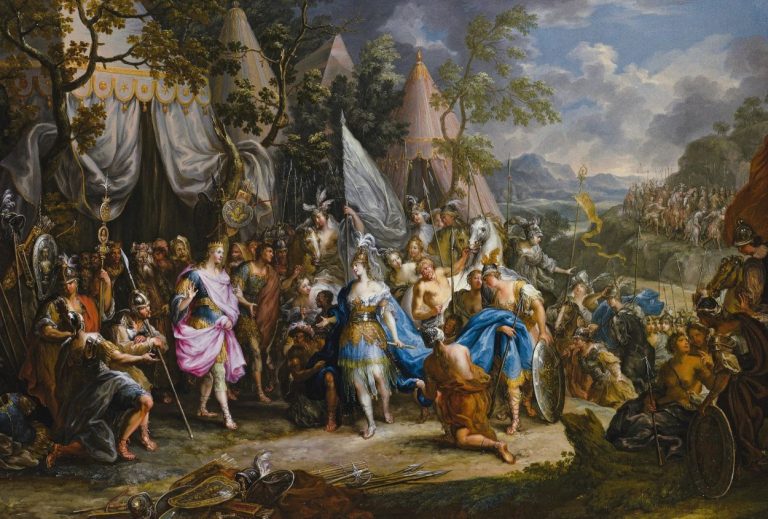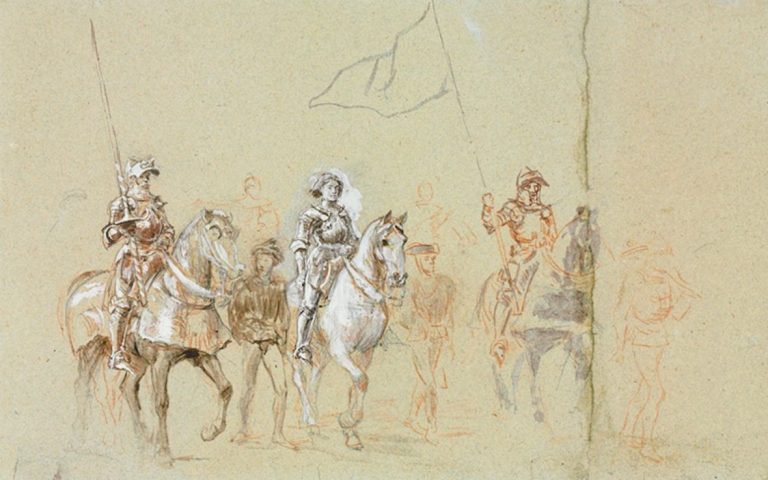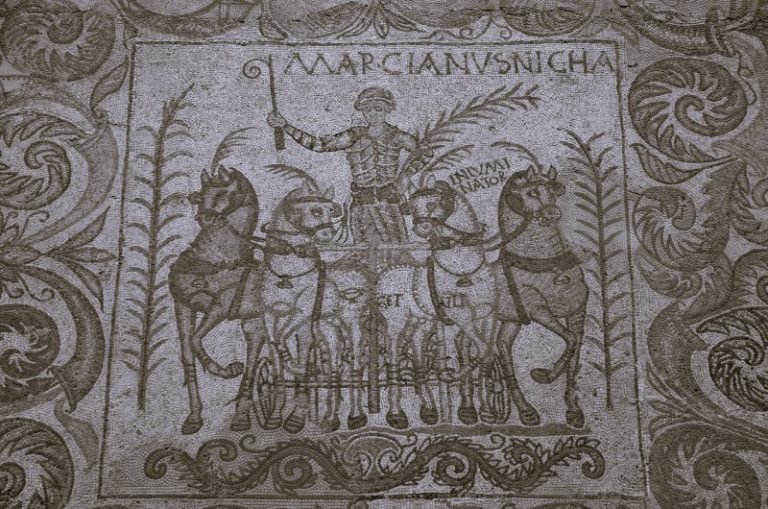
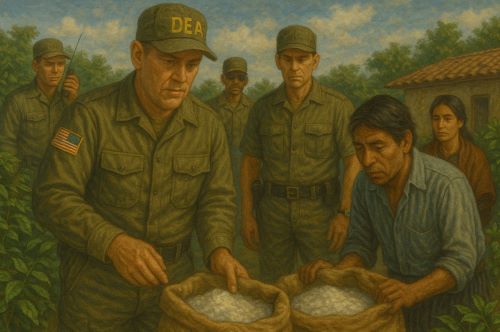
The war on drugs, for all its failures and contradictions, succeeded in one respect: it offered a new justification for an old order, where sovereignty bends to power and justice serves the needs of the strong.

By Matthew A. McIntosh
Public Historian
Brewminate
Introduction: The Empire That Would Not End
The history of U.S.–Latin American relations has always been saturated with contradiction. For over a century, the language of liberty cloaked policies of domination, and gestures toward partnership concealed a deep asymmetry of power. This imperial residue did not vanish with the Cold War. Instead, it found new expression in a crusade against narcotics. Beginning with Richard Nixon’s declaration of a “war on drugs” in 1971 and intensifying under Ronald Reagan in the 1980s, the campaign against illicit substances served not only as domestic social policy but as a hemispheric strategy of control. Nowhere was this more apparent than in Latin America, where the war on drugs provided a moral pretext and operational framework for extending U.S. influence.
This was not merely a new chapter in drug interdiction. It was an old logic in modern uniform. The war on drugs functioned as a continuation of colonial structures, recoded through the language of security, moral hygiene, and international cooperation. Underneath the surface of anti-narcotics rhetoric lay deeper structures of economic dependency, political destabilization, and territorial intrusion. Here I explore how Nixon and Reagan’s drug policies exacerbated long-standing patterns of colonial extraction and control, transforming Latin American landscapes and governments into laboratories for imperial enforcement disguised as anti-crime policy.
Nixon’s Crusade: Domestic Panic, Foreign Proxy
Origins of the Drug War and the Racialization of Policy
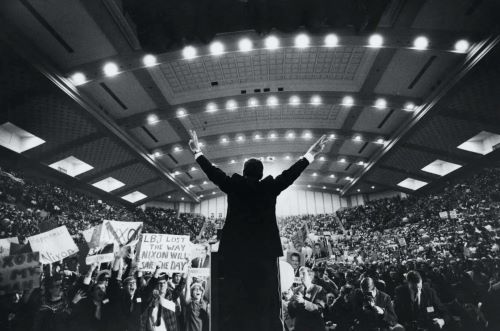
When President Nixon declared drugs “public enemy number one” in 1971, he tapped into a growing moral panic within the United States, but he also laid the groundwork for a global policing apparatus. Domestically, the war on drugs served as a means of social regulation. As later revealed by Nixon aide John Ehrlichman, the administration linked Black Americans and antiwar activists to heroin and marijuana in order to criminalize dissent and consolidate political control.1 The international extension of this logic followed naturally. If drug use could be racialized and weaponized at home, drug production could be racialized and militarized abroad.
In Latin America, this meant a shift from economic development to narcotics enforcement as the primary vector of U.S. engagement. Countries like Mexico and Colombia, which had previously received limited U.S. attention outside of Cold War alignment, were suddenly brought into the security spotlight. Nixon’s administration pressured foreign governments to adopt stricter narcotics laws, allowed U.S. agents to operate within foreign jurisdictions, and expanded funding for interdiction operations along the U.S.–Mexico border.2
Operation Intercept and the Reshaping of Sovereignty
One of the most dramatic expressions of Nixon’s early drug war was Operation Intercept in 1969, a program of aggressive border surveillance aimed at halting the flow of Mexican marijuana into the United States.3 For nineteen days, all vehicles entering from Mexico were subjected to intense inspection, bringing trade and travel to a near standstill. While officially justified as a law enforcement initiative, the operation served as geopolitical theater, asserting U.S. dominance and signaling that hemispheric compliance would be policed through economic disruption if necessary.
Mexico responded with diplomatic fury, viewing the operation as a breach of sovereignty. But the message had been sent. The war on drugs would not respect national borders. It would override them.
Reagan’s Escalation: Militarization and Neocolonial Theater
From Policing to War: The Convergence of Drugs and Counterinsurgency
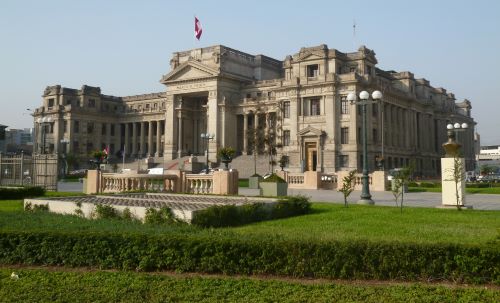
If Nixon’s drug war established the ideological scaffolding for U.S. intervention, Reagan’s tenure solidified its operational machinery. The 1980s saw the full militarization of anti-drug efforts, with Latin America becoming a strategic arena for both narcotics interdiction and Cold War counterinsurgency. The two were often indistinguishable. In places like Bolivia, Peru, and Colombia, the U.S. trained and equipped local security forces under the banner of drug enforcement, even as those same forces targeted leftist movements and indigenous communities.4
The Reagan administration framed drug trafficking as a national security threat, a rhetorical maneuver that justified unprecedented levels of foreign intervention. In practice, this meant a surge in funding for military aid, covert operations, and paramilitary alliances. The Department of Defense was authorized to share intelligence and equipment with foreign anti-drug units, blurring the line between policing and warfare.5 The logic of anti-communism migrated into a new idiom, but its tools and targets remained familiar.
Plan Colombia’s Precedents: Aerial Spraying and Economic Devastation
Though often associated with later administrations, the precursors to Plan Colombia took shape under Reagan. Aerial herbicide campaigns in the Andes, conducted with U.S. support, aimed to eradicate coca crops through chemical defoliation. The environmental consequences were devastating, contaminating water supplies, destroying food crops, and displacing rural populations.6
These campaigns were often blind to the structural conditions that made coca cultivation necessary. In regions abandoned by state infrastructure and plagued by economic precarity, coca served as a survival strategy. The U.S. approach, however, treated coca farmers as complicit in drug trafficking rather than as casualties of global inequality. This moral simplification erased the complex economic and historical realities of rural Latin America, replacing them with a binary of good and evil, law and lawlessness.
As a result, the drug war deepened rural marginalization while empowering military elites and corrupt regimes. It perpetuated a neocolonial logic in which Latin American land was rendered subject to foreign purification campaigns, and Latin American bodies were subject to foreign categories of guilt.
Colonial Continuities: Extraction, Subordination, and the Language of Reform
The Commodification of Intervention

In both Nixon’s and Reagan’s versions of the drug war, Latin America functioned as a commodity, its land, labor, and sovereignty instrumentalized in service of U.S. domestic anxieties. The extraction of raw materials had long characterized colonial relations. Under the drug war, this extraction shifted from silver and sugar to legitimacy and compliance. Success was measured not by the well-being of Latin American societies but by the volume of seizures, arrests, and destroyed crops, metrics that rewarded spectacle over substance.7
This logic paralleled earlier colonial regimes in its emphasis on quotas, surveillance, and punishment. What had once been measured in tons of ore was now measured in kilos of cocaine. The mechanisms of domination adapted but did not disappear. They simply shifted categories.
The Rhetoric of Civilization Redux
U.S. policymakers frequently described Latin American states as weak, corrupt, or incapable of governing their own territories. This narrative provided a convenient justification for intervention, casting the United States as a civilizing force confronting barbarism. Such language echoed the paternalism of earlier imperial projects, which portrayed colonized peoples as in need of discipline and reform.8
Yet the real disorder was not native dysfunction but global inequality. The demand for drugs was driven largely by U.S. consumers, and the profits flowed upward through transnational financial systems often beyond the reach of any farmer or mule. To target the supply side in Latin America while ignoring the demand and distribution networks in the Global North was not merely ineffective. It was strategically self-serving.
Conclusion: The Empire Repackaged
The war on drugs under Nixon and Reagan did not introduce colonial exploitation to Latin America. It reanimated it. Under the guise of law enforcement and international cooperation, it reproduced the structures of control, hierarchy, and economic dependency that had long defined the region’s relationship with the United States. The language of narcotics replaced that of civilization, but the script remained intact.
In tracing this history, one confronts the uncomfortable continuity of empire, not as territorial conquest but as ideological persistence. The war on drugs, for all its failures and contradictions, succeeded in one respect: it offered a new justification for an old order, where sovereignty bends to power and justice serves the needs of the strong.
Appendix
Footnotes
- Dan Baum, “Legalize It All,” Harper’s Magazine, April 2016, https://harpers.org/archive/2016/04/legalize-it-all/.
- William O. Walker III, Drug Control in the Americas (Albuquerque: University of New Mexico Press, 1989), 67–70.
- Peter Andreas, Border Games: Policing the U.S.–Mexico Divide (Ithaca: Cornell University Press, 2000), 57–61.
- Coletta A. Youngers and Eileen Rosin, eds., Drugs and Democracy in Latin America: The Impact of U.S. Policy (Boulder: Lynne Rienner, 2005), 88–91.
- Martha Huggins, Political Policing: The United States and Latin America (Durham: Duke University Press, 1998), 201–204.
- Winifred Tate, Counting the Dead: The Culture and Politics of Human Rights Activism in Colombia (Berkeley: University of California Press, 2007), 138–140.
- Eduardo Galeano, Open Veins of Latin America: Five Centuries of the Pillage of a Continent (New York: Monthly Review Press, 1973), 264–266.
- Julian Go, Patterns of Empire: The British and American Empires, 1688 to the Present (Cambridge: Cambridge University Press, 2011), 285–287.
Bibliography
- Andreas, Peter. Border Games: Policing the U.S.–Mexico Divide. Ithaca: Cornell University Press, 2000.
- Baum, Dan. “Legalize It All.” Harper’s Magazine, April 2016, https://harpers.org/archive/2016/04/legalize-it-all/.
- Galeano, Eduardo. Open Veins of Latin America: Five Centuries of the Pillage of a Continent. New York: Monthly Review Press, 1973.
- Go, Julian. Patterns of Empire: The British and American Empires, 1688 to the Present. Cambridge: Cambridge University Press, 2011.
- Huggins, Martha. Political Policing: The United States and Latin America. Durham: Duke University Press, 1998.
- Tate, Winifred. Counting the Dead: The Culture and Politics of Human Rights Activism in Colombia. Berkeley: University of California Press, 2007.
- Walker, William O., III. Drug Control in the Americas. Albuquerque: University of New Mexico Press, 1989.
- Youngers, Coletta A., and Eileen Rosin, eds. Drugs and Democracy in Latin America: The Impact of U.S. Policy. Boulder: Lynne Rienner, 2005.
Originally published by Brewminate, 08.06.2025, under the terms of a Creative Commons Attribution-NonCommercial-NoDerivatives 4.0 International license.
